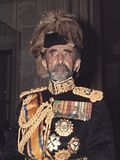Empress of Ethiopia
| Emperor of Ethiopia | |
|---|---|
|
Imperial
|
|

|
|

Haile Selassie I
|
|
| Details | |
| Style | His Imperial Majesty |
| First monarch | Menelik I |
| Last monarch | Haile Selassie I |
| Formation | c. 980 BC |
| Abolition | 21 March 1975 |
| Residence | Menelik Palace |
| Appointer | Hereditary |
| Pretender(s) | Zera Yacob Amha Selassie |
The Emperor of Ethiopia (Ge'ez: ንጉሠ ነገሥት?, nəgusä nägäst, "King of Kings") was the hereditary ruler of the Ethiopian Empire, until the abolition of the monarchy in 1975. The Emperor was the head of state and head of government, with ultimate executive, judicial and legislative power in that country. A National Geographic Magazine article called imperial Ethiopia "nominally a constitutional monarchy; in fact [it was] a benevolent ".
The title of "King of Kings", often rendered imprecisely in English as "Emperor", dates back to ancient Mesopotamia, but was used in Axum by King Sembrouthes (c. 250 AD). However, Yuri Kobishchanov dates this usage to the period following the Persian victory over the Romans in 296-297. Its use, from at least the reign of Yekuno Amlak onward, meant that both subordinate officials and tributary rulers, notably the gubernatorial vassals of Gojjam (who ranked 12th in the states non-dynastic protocol as per 1690), Welega, the seaward provinces and later Shewa, received the honorific title of nəgus, a word for "king."
...
Wikipedia
